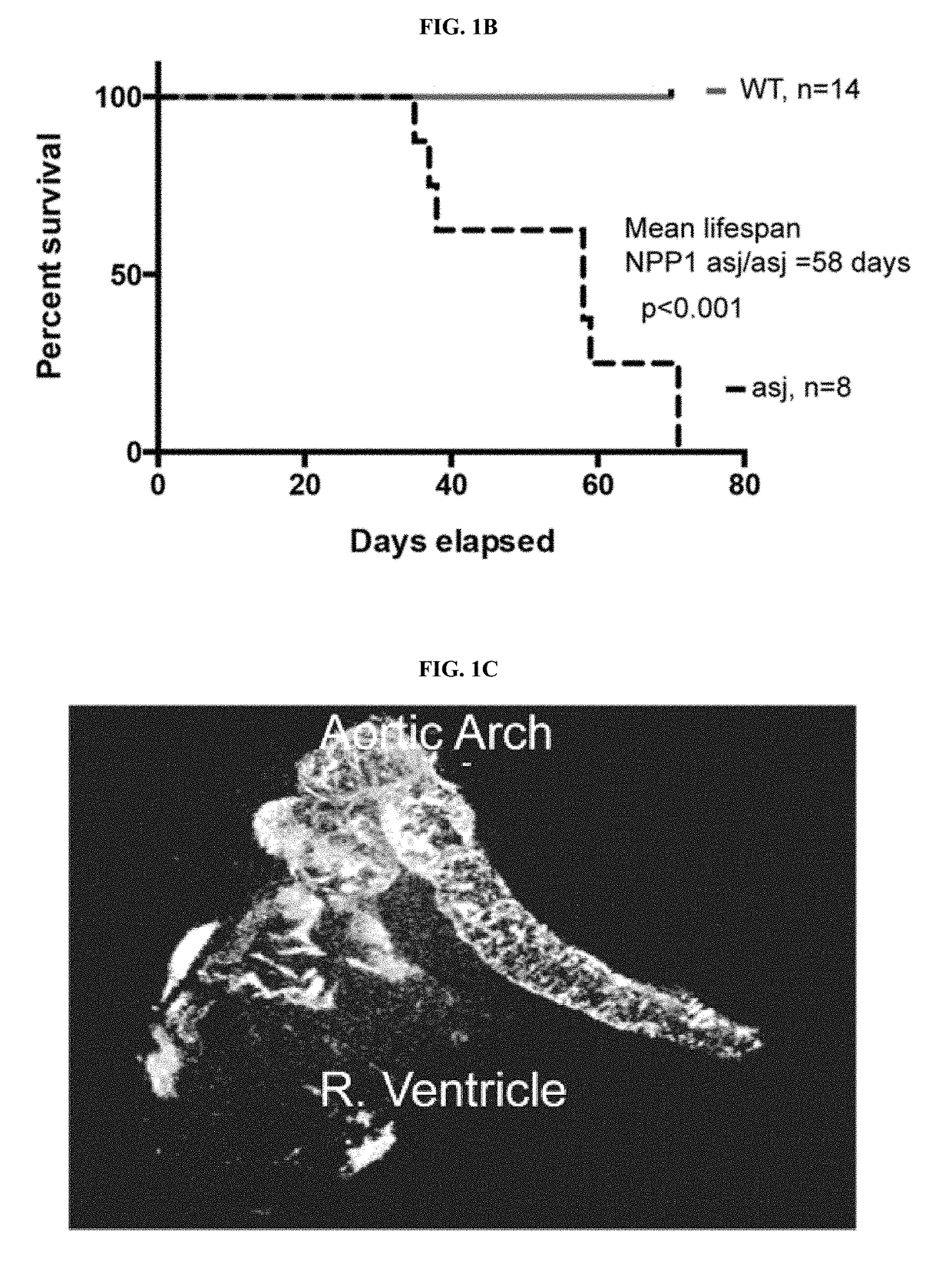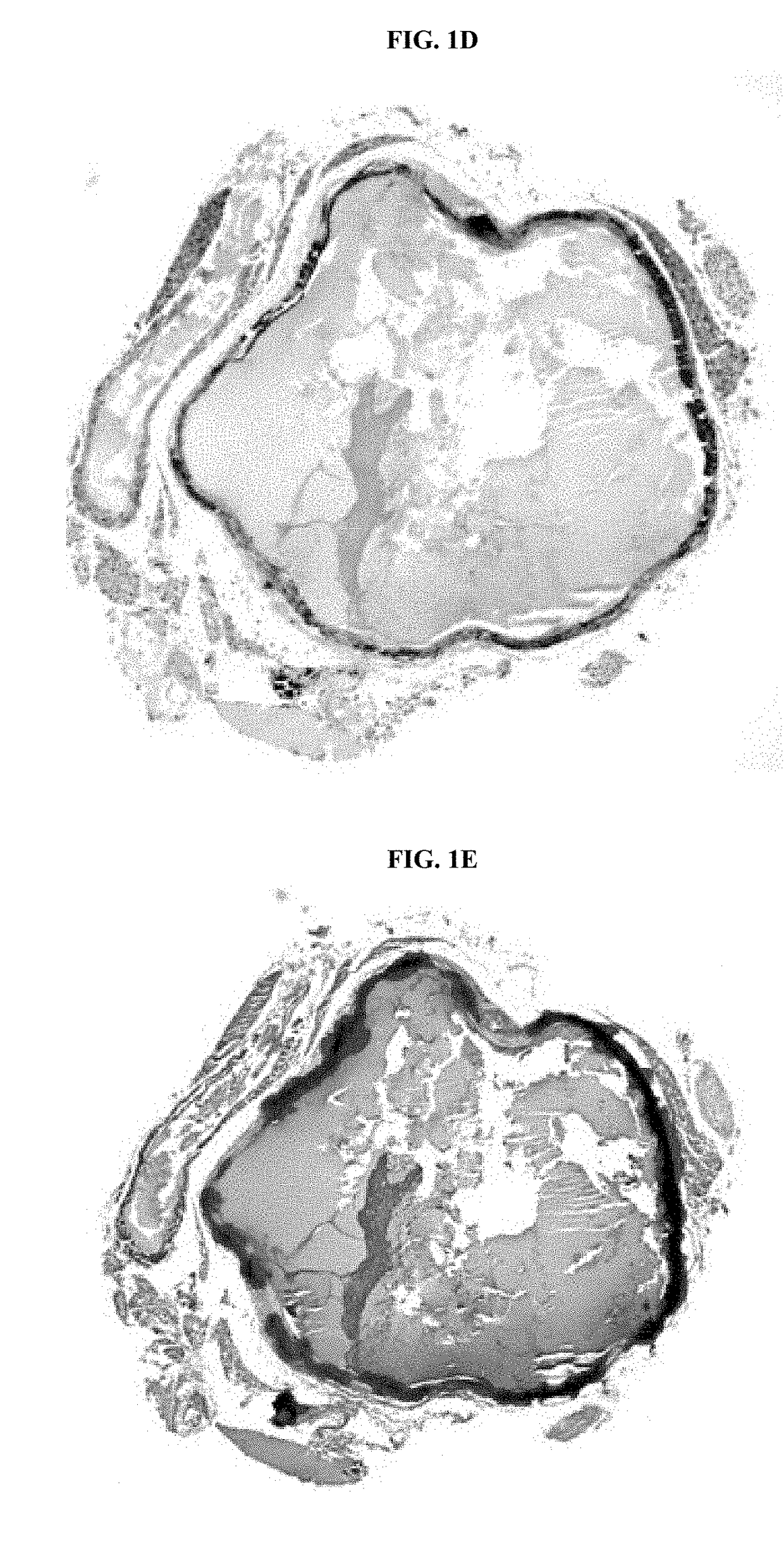Compositions for Treating Pathological Calcification Conditions, and Methods Using Same
a pathological calcification and composition technology, applied in the direction of drug compositions, peptides, cardiovascular disorders, etc., can solve the problems of inability to appropriately regulate the serum mineral balance of kidney failure, the ineffectiveness of bisphosphonates to prevent mortality in some patients, and the difficulty in determining if the treatment of bisphosphonates is truly protective, etc., to achieve the effect of reducing or preventing cardiac calcification
- Summary
- Abstract
- Description
- Claims
- Application Information
AI Technical Summary
Benefits of technology
Problems solved by technology
Method used
Image
Examples
example 1
PXE Mouse Model
[0233]Certain polypeptides of the invention (such as ENPP1-Fc) were tested in mouse models of PXE and osteoarthritis (OA). The PXE mice present the loss of function mutation in the multi-pass membrane transporter ABCC6, in a similar fashion to humans with PXE. ANK mice were used as a mammalian model for OA.
[0234]Heterozygous ENPP1-asj / + breeding pairs were maintained on the “acceleration diet” (TD00.442, Harlan Laboratories, Madison Wis.) throughout the entire experiment to generate ENPP1-WT and ENPP1-asj / asj sibling pairs that had been exposed to the acceleration diet in utero. Liters were genotyped on day 8 and weaned at day 21. Following weaning, sibling pairs were divided into experimental cohorts and all experimental animals were maintained on the acceleration diet through completion of the study. Selected polypeptides of the invention were administered to study animals, as described herein, and bones are analyzed.
[0235]As illustrated in FIG. 7, both PXE and ANK ...
example 2
[0238]When fed an acceleration diet, the daily weights of ENPP1-asj / asj mice diverged from WT siblings pairs at day 26, when the ENPP1-asj / asj mice experienced a “failure to thrive” event and began to lose weight (FIG. 1A). After day 26 the ENPP1-asj / asj animals displayed progressive stiffness and reductions in physical activity. All of the ENPP1-asj / asj animals died between days 35-71, with a median lifespan of 58 days (FIG. 1G). The presence of calcifications in ENPP1-asj / asj and ENPP1-WT mice was evaluated post mortem by micro-CT scans and histologic sections taken from the heart, aorta, and kidneys. Approximately one-third of the ENPP1-asj / asj mice had visible calcifications in their hearts, and two-thirds had visible calcifications in their aortas, by micro-CT imaging (Table 2). These percentages increased to 100% upon histologic examination, which also showed that many of the animals had dramatic nearly circumferential calcifications in their aortic walls (FIGS. 1D-1E). Histol...
example 3
n of Albumin Fusion Protein
[0247]Human serum albumin (HSA), a protein of 585 amino acids, is responsible for a significant proportion of the osmotic pressure of serum and also functions as a carrier of endogenous and exogenous ligands. At present, HSA for clinical use is produced by extraction from human blood. Production of recombinant HSA (rHSA) in microorganisms has been disclosed in EP 0 330 451 and EP 0 361 991.
[0248]The role of albumin as a carrier molecule and its inert nature are desirable properties for use as a stabilizer and transporter of polypeptides. Use of albumin as a component of a fusion protein for stabilizing other proteins has been disclosed in WO 93 / 15199, WO 93 / 15200, and EP 0 413 622. The use of N-terminal fragments of HSA for fusions to polypeptides has also been disclosed (EP 0 399 666). Fusion to the polypeptide is achieved by genetic manipulation, such that the DNA coding for HSA, or a fragment thereof, is joined to the DNA coding for the polypeptide. A s...
PUM
| Property | Measurement | Unit |
|---|---|---|
| Dimensionless property | aaaaa | aaaaa |
| Dimensionless property | aaaaa | aaaaa |
| Dimensionless property | aaaaa | aaaaa |
Abstract
Description
Claims
Application Information
 Login to View More
Login to View More - R&D
- Intellectual Property
- Life Sciences
- Materials
- Tech Scout
- Unparalleled Data Quality
- Higher Quality Content
- 60% Fewer Hallucinations
Browse by: Latest US Patents, China's latest patents, Technical Efficacy Thesaurus, Application Domain, Technology Topic, Popular Technical Reports.
© 2025 PatSnap. All rights reserved.Legal|Privacy policy|Modern Slavery Act Transparency Statement|Sitemap|About US| Contact US: help@patsnap.com



